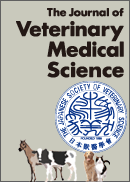Volume 83, Issue 3
March
Displaying 1-31 of 31 articles from this issue
- |<
- <
- 1
- >
- >|
Anatomy
-
2021Volume 83Issue 3 Pages 512-521
Published: 2021
Released on J-STAGE: April 03, 2021
Advance online publication: February 19, 2021Download PDF (2749K)
Avian Pathology
-
2021Volume 83Issue 3 Pages 522-526
Published: 2021
Released on J-STAGE: April 03, 2021
Advance online publication: January 12, 2021Download PDF (1156K)
Bacteriology
-
2021Volume 83Issue 3 Pages 358-369
Published: 2021
Released on J-STAGE: March 11, 2021
Advance online publication: January 12, 2021Download PDF (2318K)
Immunology
-
2021Volume 83Issue 3 Pages 441-446
Published: 2021
Released on J-STAGE: April 03, 2021
Advance online publication: February 08, 2021Download PDF (1457K)
Internal Medicine
-
2021Volume 83Issue 3 Pages 370-377
Published: 2021
Released on J-STAGE: March 11, 2021
Advance online publication: January 19, 2021Download PDF (1982K) -
2021Volume 83Issue 3 Pages 447-455
Published: 2021
Released on J-STAGE: April 03, 2021
Advance online publication: January 25, 2021Download PDF (803K) -
2021Volume 83Issue 3 Pages 378-384
Published: 2021
Released on J-STAGE: March 11, 2021
Advance online publication: January 12, 2021Download PDF (2978K) -
2021Volume 83Issue 3 Pages 385-389
Published: 2021
Released on J-STAGE: March 11, 2021
Advance online publication: January 13, 2021Download PDF (2189K) -
2021Volume 83Issue 3 Pages 456-460
Published: 2021
Released on J-STAGE: April 03, 2021
Advance online publication: January 20, 2021Download PDF (1084K) -
2021Volume 83Issue 3 Pages 461-468
Published: 2021
Released on J-STAGE: April 03, 2021
Advance online publication: January 27, 2021Download PDF (3359K) -
2021Volume 83Issue 3 Pages 465-468
Published: 2021
Released on J-STAGE: April 03, 2021
Advance online publication: February 01, 2021Download PDF (3085K)
Laboratory Animal Science
-
2021Volume 83Issue 3 Pages 390-396
Published: 2021
Released on J-STAGE: March 11, 2021
Advance online publication: January 20, 2021Download PDF (1706K) -
2021Volume 83Issue 3 Pages 397-402
Published: 2021
Released on J-STAGE: March 11, 2021
Advance online publication: January 10, 2021Download PDF (8284K) -
2021Volume 83Issue 3 Pages 403-411
Published: 2021
Released on J-STAGE: March 11, 2021
Advance online publication: January 25, 2021Download PDF (2826K)
Parasitology
-
2021Volume 83Issue 3 Pages 412-418
Published: 2021
Released on J-STAGE: March 11, 2021
Advance online publication: January 19, 2021Download PDF (1559K)
Pathology
-
2021Volume 83Issue 3 Pages 419-426
Published: 2021
Released on J-STAGE: March 11, 2021
Advance online publication: January 04, 2021Download PDF (3822K) -
2021Volume 83Issue 3 Pages 427-430
Published: 2021
Released on J-STAGE: March 11, 2021
Advance online publication: January 19, 2021Download PDF (2708K) -
2021Volume 83Issue 3 Pages 469-472
Published: 2021
Released on J-STAGE: April 03, 2021
Advance online publication: January 26, 2021Download PDF (4184K) -
2021Volume 83Issue 3 Pages 473-477
Published: 2021
Released on J-STAGE: April 03, 2021
Advance online publication: January 29, 2021Download PDF (2097K) -
2021Volume 83Issue 3 Pages 527-530
Published: 2021
Released on J-STAGE: April 03, 2021
Advance online publication: February 02, 2021Download PDF (4670K)
Physiology
-
2021Volume 83Issue 3 Pages 478-481
Published: 2021
Released on J-STAGE: April 03, 2021
Advance online publication: January 20, 2021Download PDF (1047K)
Public Health
-
2021Volume 83Issue 3 Pages 482-486
Published: 2021
Released on J-STAGE: April 03, 2021
Advance online publication: January 19, 2021Download PDF (1246K) -
2021Volume 83Issue 3 Pages 531-534
Published: 2021
Released on J-STAGE: April 03, 2021
Advance online publication: January 21, 2021Download PDF (752K)
Theriogenology
-
2021Volume 83Issue 3 Pages 535-541
Published: 2021
Released on J-STAGE: April 03, 2021
Advance online publication: February 04, 2021Download PDF (1132K) -
2021Volume 83Issue 3 Pages 431-434
Published: 2021
Released on J-STAGE: March 11, 2021
Advance online publication: January 15, 2021Download PDF (734K)
Toxicology
-
2021Volume 83Issue 3 Pages 487-500
Published: 2021
Released on J-STAGE: April 03, 2021
Advance online publication: January 25, 2021Download PDF (4837K) -
2021Volume 83Issue 3 Pages 542-548
Published: 2021
Released on J-STAGE: April 03, 2021
Advance online publication: February 01, 2021Download PDF (3897K)
Virology
-
2021Volume 83Issue 3 Pages 549-557
Published: 2021
Released on J-STAGE: April 03, 2021
Advance online publication: October 28, 2020Download PDF (3718K)
Wildlife Science
-
2021Volume 83Issue 3 Pages 435-440
Published: 2021
Released on J-STAGE: March 11, 2021
Advance online publication: January 21, 2021Download PDF (1238K) -
2021Volume 83Issue 3 Pages 501-506
Published: 2021
Released on J-STAGE: April 03, 2021
Advance online publication: February 22, 2021Download PDF (1287K) -
New canine parvovirus 2a infection in an imported Asian small-clawed otter (Aonyx cinereus) in Japan2021Volume 83Issue 3 Pages 507-511
Published: 2021
Released on J-STAGE: April 03, 2021
Advance online publication: January 21, 2021Download PDF (3000K)
- |<
- <
- 1
- >
- >|
